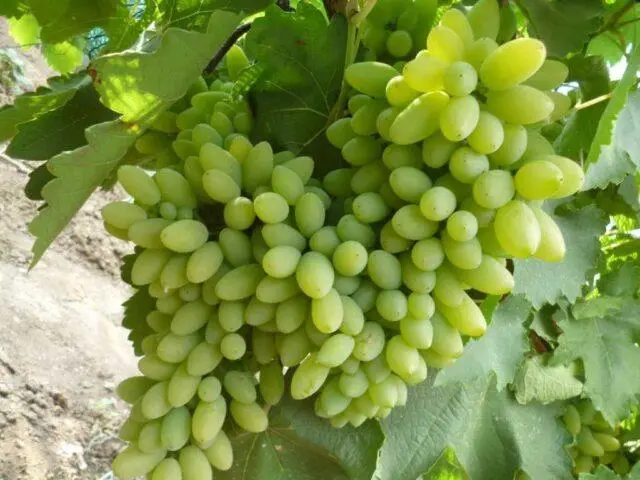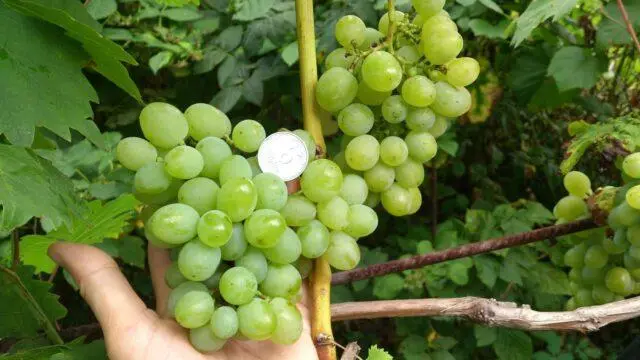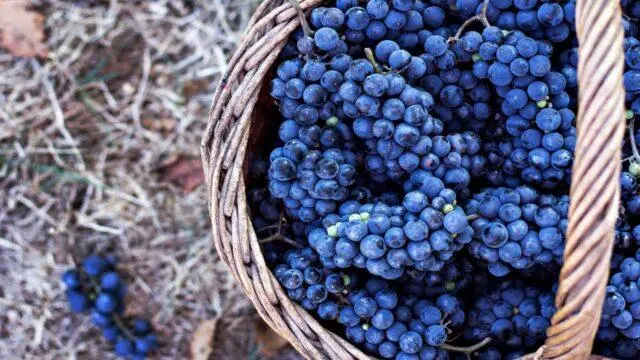Contents
White bloom on grape berries and leaves is a characteristic sign of disease damage to the crop. And if you do not take timely measures to protect the plant, then you should not count on a good harvest, not only in the current, but also in subsequent seasons. However, before proceeding with the treatment of grapes, it is necessary to initially determine the disease that caused the appearance of white plaque. Because sometimes it can also be caused by the presence of a pest or a lack of certain nutrients in the soil.
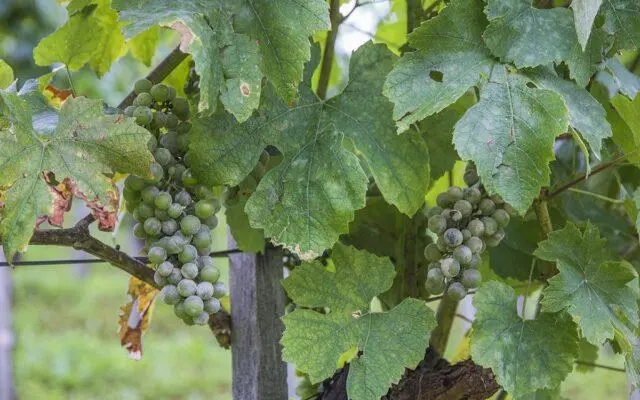
It is impossible to completely exclude the possibility of white bloom on the grapes.
Why do grapes turn white
Grapes are considered a demanding crop. For the full development and regular fruiting of the vine, certain conditions and proper care are necessary. If they do not match, the immunity of the plant decreases, and the likelihood of its damage by diseases increases. Mistakes in agricultural technology can also contribute to the appearance of white bloom on berries and leaves on grapes.
Provoking factors:
- prolonged stagnation of moisture in the soil;
- sharp temperature drops;
- density of landings;
- insufficient ventilation of plants
- high humidity;
- lack of nutrients;
- bad light;
- inconsistency in climatic conditions.
Diseases of grapes with white bloom
There are several common crop diseases that are characterized by the appearance of this symptom. Therefore, every gardener who grows grapes should know the distinctive features of white bloom, which will allow you to identify the problem at an early stage of the lesion.
Oidium
This disease is also called powdery mildew. The causative agent is the fungus Uncinula necator Burri. Oidium first appeared in North America and then spread throughout the world.
The disease can be recognized by a white coating on the leaves, which is initially insignificant, as powdery mildew progresses, it completely covers the plate. Subsequently, it acquires a grayish tint. White plaque interferes with the process of photosynthesis. As a result, the affected leaves wither and darken. In the absence of control measures, the disease spreads to shoots, inflorescences.
The berries, if tied, then subsequently crack under the influence of moldy fungi or dry out.
The incubation period of the disease is 7-14 days. Favorable conditions for the development of the fungus – a temperature of + 23-25 ° C, combined with high humidity. White bloom with powdery mildew appears in late spring, early summer.
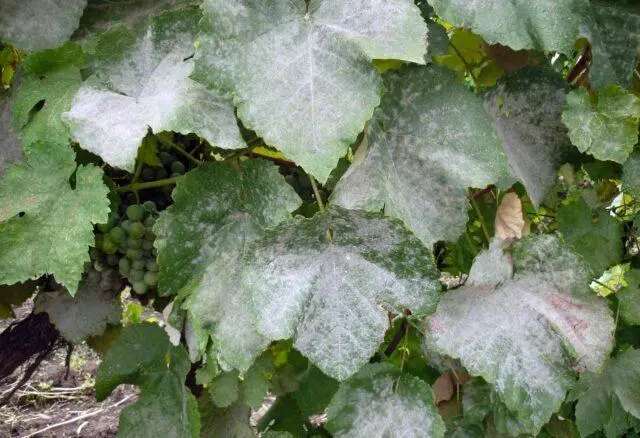
When affected by powdery mildew, the vine does not ripen
Mildew
The second name of the disease is downy mildew. The fungus infects leaves, shoots and berries of grapes. The first mention of it appeared in 1878, when affected cultures were discovered in North America. Subsequently, signs of mildew appeared in the south of France, and then the disease spread throughout the world. The causative agent is a fungus – Plasmopara viticola Berl. et Toni.
Mildew can be recognized at the initial stage of development by an oily spot that appears on young growing leaves. Subsequently, with increased humidity, a white coating appears on the affected areas on the reverse side of the plate, which indicates the sporulation of the fungus.
Downy mildew is characterized by a rapid development process. And if yesterday the grapes looked quite healthy, today they may already have a “depressed” look. Subsequently, the affected leaf tissues die off. And the white bloom switches to inflorescences and clusters. Optimal conditions for the development of mildew are temperature + 23-25 ° C and high humidity.
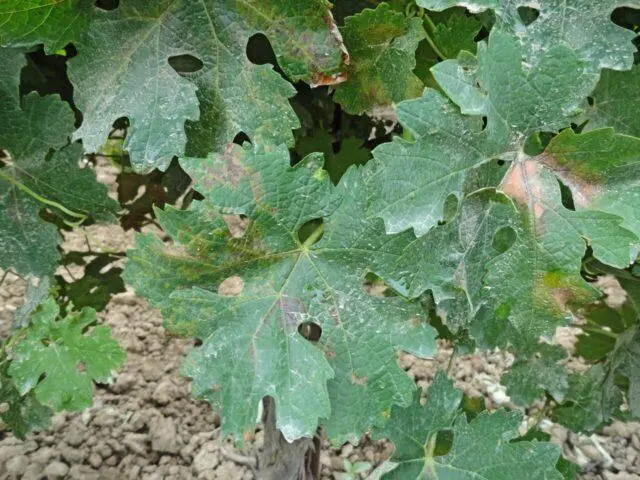
If left untreated, grapes can die from downy mildew.
Alternaria
The causative agent of this disease is the fungus Alternaria solani Ell. et Mart Initially, small white tubercles appear on the leaves of the grapes, inside which spores ripen. If you look closely, you can find necrotic areas in the center of such a spot. Signs of the disease appear on the vine. After 5-6 days, at high humidity, the growths open, and the spores of the fungus are carried by the wind.
Alternariosis also affects bunches of grapes. In this case, a metallic sheen appears on the berries. As a result, the surface of the fruit becomes wrinkled, the taste is reduced. The provoking factors for the development of the fungus are elevated temperature and humidity for a long time.
To distinguish alternariosis from true and downy mildew, you need to lower the suspicious leaf into a container of water and put it in a warm place. After a few hours, a light olive coating should appear on the affected area, which indicates Alternaria.
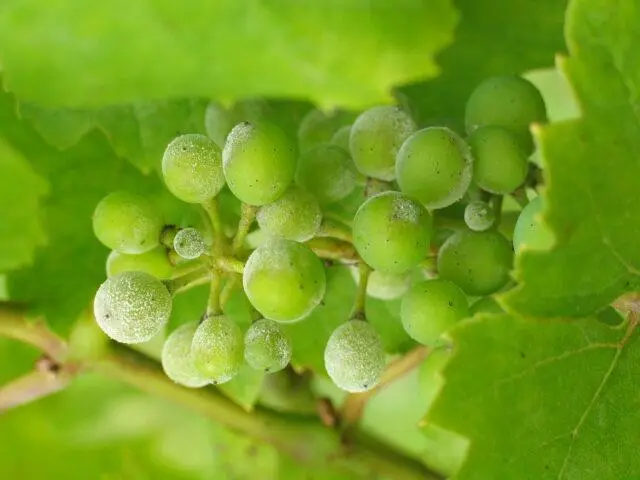
Alternariosis is characterized by a short incubation period
aspergillus rot
The causative agents of this disease are ten species of fungi from the genus Aspergillus. Aspergillus rot is common in the southern regions. It affects berries during prolonged drought and high air temperature.
A characteristic sign of damage is light depressed spots on the berries, which then darken. Subsequently, they crack, and a white coating of mycelium and conidial sporulation appear on them in the form of a black-brown powdery mass. With a strong defeat, the clusters become completely black.
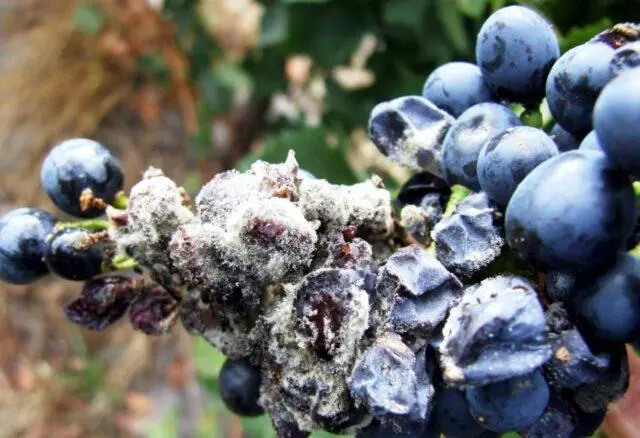
Aspergillosis develops when the sugar content of fruits reaches 8%.
Gray mold
This disease in the form of a white thick coating can appear on the leaves, shoots and fruits of grapes. It affects the plant at any stage of development in the presence of favorable conditions – cold damp weather. You can recognize it by a white coating on the leaves of the grapes from above, as well as blooming eyes, young shoots. Subsequently, they turn brown and increase in size.
Progresses with high humidity and poorly ventilated plantings. At the same time, the water content in the fruits decreases, and the sugar content increases. But if it rains, then this provokes massive rotting of the crop.
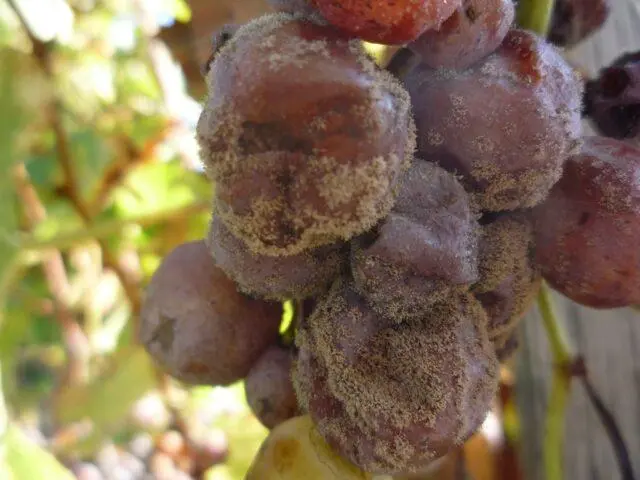
White plaque with gray rot appears on the annual vine
Felt mite (grape itch)
White spots on the leaves of grapes can also appear as a result of damage to the plant by a felt mite or itch (Eriophyes vitis Pgst). This microscopic pest infects the leaves and feeds on the sap of the plant. As a result, characteristic swellings appear on the plates. On the reverse side of the leaf, the affected areas are covered with a thick, felty white coating.
Felt leaf larvae overwinter in bud scales. And with the arrival of spring warmth, the life cycle of the pest resumes. Signs of itching usually appear on the lower leaves of the vine.
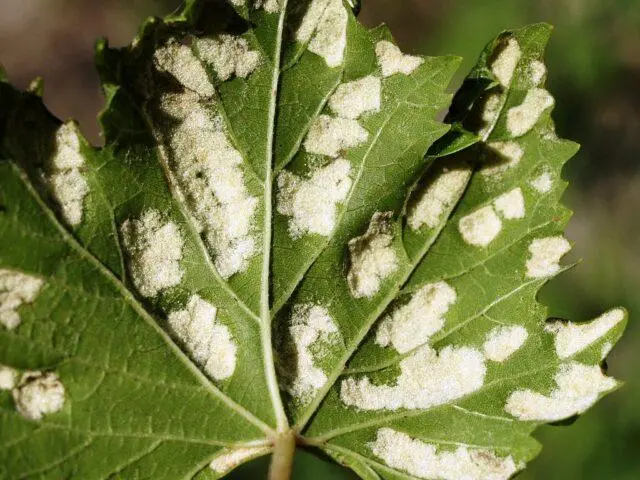
Grape itch does not cause serious damage to grapes
Chlorosis
The disease develops with an increased content of lime in the soil or a lack of iron. As a result, the leaf plates lose their green pigment and become almost white, but the veins retain a rich shade. This leads to disruption of the photosynthesis process. As a result, the plant does not receive the necessary nutrition, which weakens it. This leads to shedding of the ovary, not ripening of berries and young vines.

Rainy cold weather contributes to the appearance of chlorosis
What to do if there is a white coating on the leaves and bunches of grapes
It is necessary to process the bushes immediately when a white bloom appears on the grapes, until the disease or pest has spread throughout the plantation. To do this, you can use chemical and folk remedies.
Preparations
Fungicides should be used to control fungal diseases. When processing, you need to spray the solution on the leaves, paying special attention to their reverse side, shoots and berries. During flowering, it is better not to carry out the procedure.
Effective drugs for the appearance of white plaque on the grapes:
- Bordeaux mixture;
- Cupritox;
- Hom;
- colloidal sulfur;
- Quadris.
To combat felt itching, insecticides should be used: Bi-58, Aktellik, Fufanon.
If chlorosis occurs, iron chelate should be used. The drug is recommended to spray the affected plants and water. Repeat the procedure every seven days until the color of the leaves is restored.
Folk remedies
It is possible to process grapes from mold with folk remedies. But it should be understood that with the massive spread of the disease, they will be ineffective. They are best used as a preventive measure, as well as when the use of chemicals is unacceptable: during the flowering and ripening of berries.
Effective folk remedies for white plaque:
- Dissolve 1 tsp. with a hill of permanent potassium in 10 liters of water. Mix the solution thoroughly and spray the affected crops.
- Mix 1 kg of mullein with 3 liters of water, leave for three days. Then stir the resulting mixture and strain. Dilute the concentrate in a ratio of 1:3 with water, leave for another three hours. Then spray the grapes.
- Add 10 g of soda ash to 40 liters of water. Mix the solution and process the grapes.
- Grind 150 g of garlic and pour it with a bucket of water, strain and immediately spray the plant. Repeat the treatment after three days.
Prevention
So that the grapes do not become covered with white bloom, you need to know how to treat it as a preventive measure. This will reduce the chance of injury to a minimum.
Experienced growers recommend using 1% copper and iron sulfate, as well as colloidal sulfur, in early spring and late autumn.
Other measures to prevent the appearance of white plaque:
- remove plant residues;
- carry out annual sanitary pruning;
- tie the whips in a timely manner;
- avoid crowded landings;
- watering only when the soil dries up 5-7 cm deep;
- regularly loosen the ground at the base of the grapes.
Disease resistant grape varieties
For successful cultivation of grapes, it is necessary to select zoned crop varieties. Inconsistency of conditions leads to the weakening of plants and, as a result, the defeat of their diseases and pests.
Resistant varieties:
- Timur;

Vegetation period Timur 105-115 days
- Harold;

Harold is a promising hybrid form of culture
- Carmenere;

Carménère is from Bordeaux
- Delight;

Rapture is characterized by increased resistance to frost and disease.
- Rochefort.

Rochefort has great growth power
Is it possible to eat infected grapes
In most cases, when a white bloom appears on the grapes, its fruits become watery and lose their sugar content. Therefore, there is no desire to use them. But in the case of gray rot, felt itch, the berries are quite edible. The main thing is to wait the necessary waiting period before harvesting after applying chemicals.
Conclusion
White bloom on grapes, as well as shoots and leaves, will not disappear on its own, as this sign indicates that the plant needs the help of a gardener. Lack of control measures can lead to the death of the shrub. Therefore, when warning signs appear, you need to act quickly so that the problem does not become widespread.










